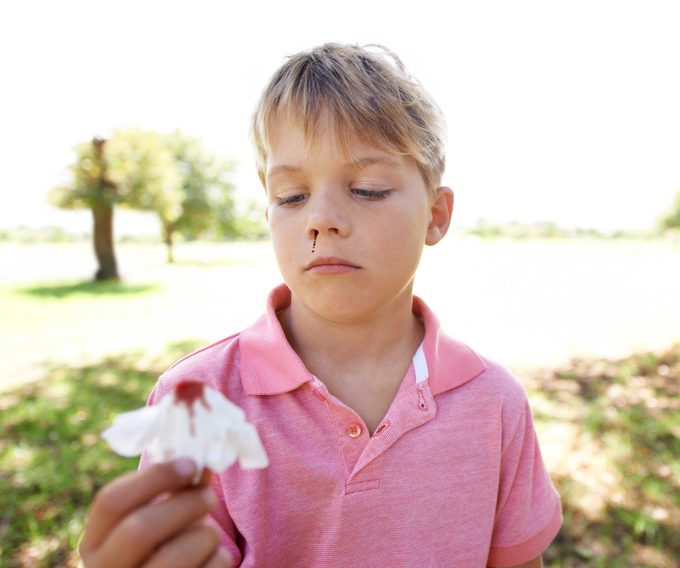The Right Way to Stop a Nosebleed
Updated: May 03, 2021
Treating a bloody nose incorrectly can prolong the bleeding and make things worse. Follow these steps to stop a nosebleed.

The most common causes of nosebleeds are dry air and nose picking. That’s only part of the dangerous reason not to pick your nose. Still, nosebleed causes could be anything from allergies or the common cold to chronic congestion or a sinus infection, according to Mayo Clinic. Very occasionally, nosebleeds (known by the medical term epistaxis) are a sign of underlying illness or injury. Very rarely, a bloody nose can be life-threatening, especially in older people. Here’s what you need to know about how to stop a nosebleed.
How to stop a nosebleed
People commonly pinch the bridge of their nose and lean back to stop a nosebleed, but according to Jason M. Abramowitz, MD, of ENT and Allergy Associates, this is counterintuitive. The right way to stop nosebleeds is to pinch your nostrils tight, Dr. Abramowitz says. “That’s going to put pressure on the front of the septum where the bleed is likely coming from,” he says. Tilt your head forward, so the blood doesn’t drip back and into your windpipe. An icepack on the bridge of your nose can help as well as a nasal decongestant spray help constrict blood vessels and stop bleeding, too, according to Dr. Abramowitz. Tipping your head back is one of the 12 common first aid mistakes everyone makes.
Maseih Moghaddassi, MD, an Ear, Nose, and Throat specialist, and the Chief of the Department of Otolaryngology and Head and Neck Surgery at NYU Winthrop Hospital offers another suggestion. “The best way is to put a cotton ball inside the nose and press the areas of the nose that flair in and out when you breathe,” Dr. Moghaddassi says. Traditionally, however, most people do this incorrectly by pressing on the nasal bone. To get the pressure right, you have to press on the soft part of the nose, Dr. Moghaddassi says. Still, Dr. Abramowitz adds that putting tissue or cotton into your nose could do more harm than good if the tissue or cotton breaks apart.
When to call the doctor
If you’ve tried how to stop a nosebleed two or three times without luck, it’s time to call your doctor, Dr. Moghaddassi says. This is especially true if the blood is bright red and flowing quickly, Dr. Abramowitz adds. “I recommend all patients who experience their first nosebleed to be evaluated by an ear nose and throat physician,” he says. “It’s important to understand the origin of the bleed and to rule out any concerning causes.” People should also see a doctor if they experience reoccurring nosebleeds, too, as they might be warning signs of other serious conditions, Dr. Moghaddassi says. Runny noses, on the other hand, are a different story. If you can’t stop reaching for tissues, check out these 12 surprising reasons you have the sniffles.
How to prevent nosebleeds
You don’t have to worry about how to stop a nosebleed if you avoid them in the first place. The ideal way to prevent nosebleeds is by keeping your nose moist. Blood vessels that come too close to the surface and crack causes the bleeding which usually happens when the nose is dry, Dr. Abramowitz says. Nasal saline or salt water spray are great over-the-counter options. You can also apply a pea size amount of Vaseline or Aquaphor to your nostrils before bed, locking in moisture. Humidifiers are another option, too. Still, while dryness is the most common reason for nosebleeds, allergies, inflammation, infection, and high blood pressure among other causes are possible. If your nosebleed is because of trauma, you’ll want to know these 60 secrets the emergency room staff won’t tell you.
Disclosure: We may earn a commission for purchases made through our links.
